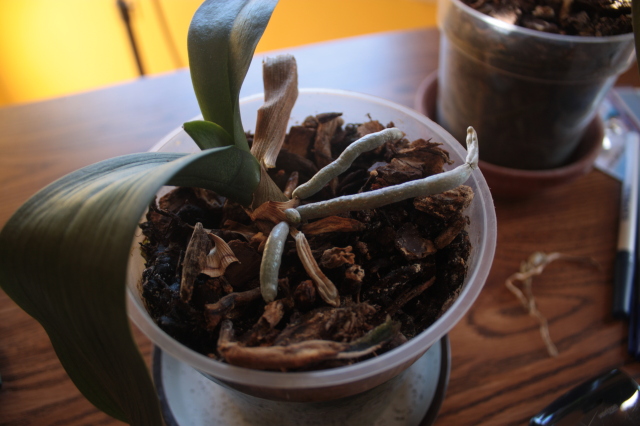Question
 Orchid 'B'
Orchid 'B'
Hi,
My Great Aunt passed away a couple of weeks ago and I inherited two of her phaleanopsis orchids from my parents 6 days ago.
One (Orchid 'A') looks fairly healthy and is flowering. The three large leaves are reddish at the base (one a bit on the edges) and some of the roots are whitish (but they don't have green tips). They are potted in a clear plastic container, and through it I see dark green roots, some with a reddish hue like the leaves. The things I am concerned about with this plant are 1) the potting medium (wood chips) has whitish sooty stuff on it - is that normal? if not what do I do and when? and 2) There are a lot of remains (roots, leaf bases) visible - again, is that normal? do I need to do something about it? if so, what do I do? I've been trying to read about orchid care and some places say to re-pot the plant, some say to wait after it's done flowering, and most say not to do it if you don't have to because of the stress on the orchid - I'm just not sure what to do.
Orchid 'B' is in much worse shape, and I am fairly nervous about it. It is much less developed than Orchid 'A', with 1 large leaf, one medium leaf, and one budding leaf and absolutely no flowering stems. The large leaf is very very droopy and just a bit wrinkly. From what I can see in the clear pot, the roots don't look so great - greenish brown and a bit wrinkly too. The potting medium has a little bit of the sooty whitish stuff on it, but not as much as Orchid 'A'. However, this orchid has a lot of dark green stuff in the pot that looks a lot like algae. Like orchid 'A', this plant has some dead leaf bases and one or two withered brown roots that look like they need removed, but I'm not exactly sure how to move forward because I've never had an Orchid before and I want to make sure I'm doing the right thing before I put stress on it.
Today is Saturday, so they were watered when I got them last Sunday and then also on Thursday because I put my finger in the medium and it felt dry to me. I have them on my desk by a window that faces the south east direction. It's a little dry here because it's winter and the heat is on (I am in Cleveland).
Basically, I could use advice about what to do with each plant, then also some accurate references to check out for the future.
Thank you!
AnswerMichelle, it is clear that both plants are in need of repotting, however, for now. I would concentrate on the nonflowering plant. In the interim, cut back on the watering of plant A and allow it to go to term on its flowering. As a general rule with orchids, if you're uncertain about watering-- don't do it. More orchids have been killed by overwatering than underwatering. When a potting mix is broken down, such as yours, it remains wet or damp much longer and limits air flow to the roots. This is also the reason that you have a white mold growing on the potting mix which can only occur on decayed potting mix that remains damp.
So, we want to repot plant B for now. Having been through this process once, you will be prepared to repot plant A when it is time. First step is to locate a good orchid potting mix. You have several orchid supply companies in or near Cleveland. I have used Roberts Flower Supply and can recommend them for your orchid supplies. They can help you choose just the right potting mix for your plants. Wayne and Nancy Roberts are the owners and they are located at 12390 Root Road, Columbia Station, OH (440-236-5571#. They also have a website www.orchidmix.com. Of course, you can also find orchid potting mix at Lowes or Home Depot but they have a couple of types #such as Miracle Grow#. If you go this route, you need to choose a type of orchid potting mix that contains some fir bark. Once you have your fresh orchid potting mix, you will need to soak it prior to use. Dry fir bark repels water and that repellency needs to be reduced by soaking it for several hours prior to use.
Remove your plant from its pot and discard the old potting mix #its okay to leave some attached to the he roots. Healthy roots are firm and turn green when wet. Rotted roots need to be removed before repotting-- they are mushy or stringy. After removing the rotted roots (if any), see if the remaining roots will comfortably fit into the old pot. Usually you will need a pot that is 1/2-1 inch larger in diameter. Place the roots into the new pot, place the pot into an area where excess moisture can drain off, and start adding the wet, fresh potting mix, tapping the sides of the pot to settle the mix about the rots. Fill the potting mix to about 1" from the top of the pot and set aside to drain. Let it drain for a day or so before moving it to you growing area.






